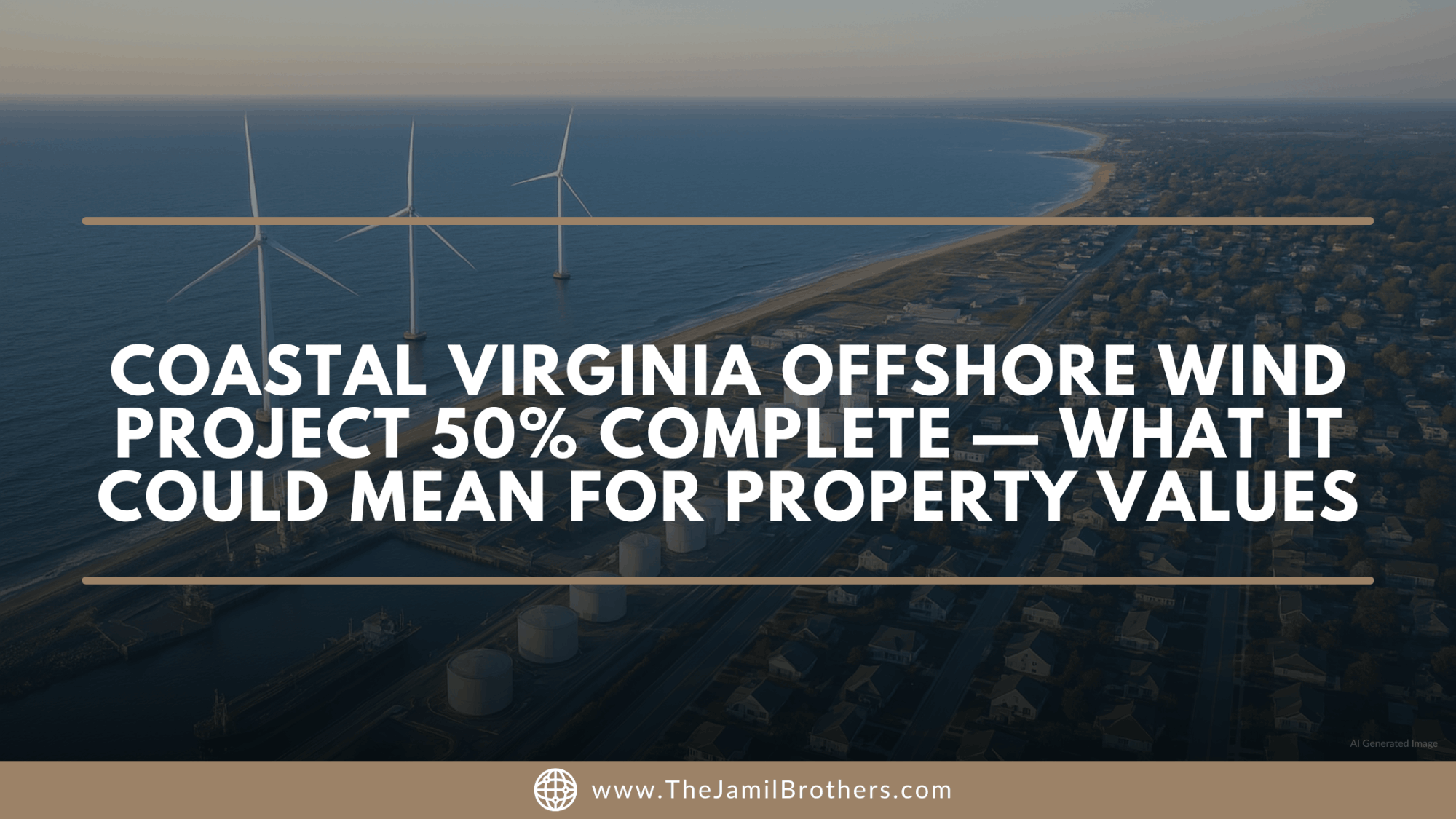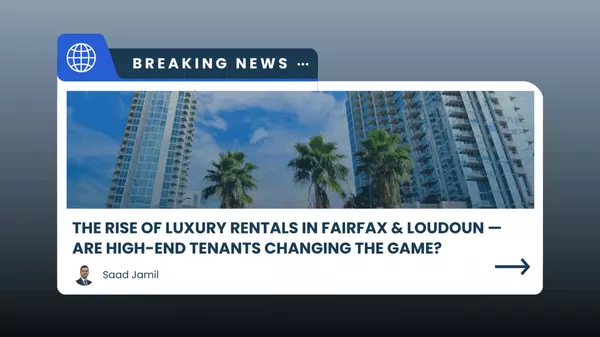Coastal Virginia Offshore Wind Project 50% Complete — What It Could Mean for Property Values

Dominion Energy’s landmark offshore wind project reaches a major milestone — and the economic ripple effects could shape Coastal Virginia’s real estate market for decades to come.
Virginia’s energy landscape is undergoing one of the most transformative changes in its history. With Dominion Energy announcing that its Coastal Virginia Offshore Wind (CVOW) project is now 50% complete, the Commonwealth stands on the brink of becoming a national leader in clean energy production. But beyond environmental progress, the ripple effects of this $9.8 billion initiative extend deeply into local economies — and even further into the real estate market.
As Virginia positions itself at the forefront of renewable infrastructure, homeowners and investors alike are beginning to ask: what does this mean for property values in Coastal Virginia, Hampton Roads, and beyond?
A Closer Look at the Coastal Virginia Offshore Wind Project
Situated approximately 27 miles off the coast of Virginia Beach, the Coastal Virginia Offshore Wind project will ultimately feature 176 wind turbines spanning 112,800 acres of ocean. When completed in 2026, it will generate over 2.6 gigawatts of clean power — enough to supply electricity to about 660,000 homes annually.
The CVOW project builds upon a smaller, two-turbine pilot phase completed in 2020 and is now one of the largest offshore wind efforts in the Western Hemisphere. Dominion Energy’s goal is to reduce Virginia’s dependence on fossil fuels, comply with the state’s Clean Economy Act, and support the national push toward carbon neutrality.
More than just energy generation, the project is a massive economic engine. It’s expected to create around 1,100 direct jobs during construction and hundreds more in ongoing maintenance and operations. The Port of Virginia has already undergone major upgrades to accommodate turbine components, positioning Hampton Roads as a key logistics and manufacturing hub for future renewable projects.
How Clean Energy Projects Influence Local Real Estate
Real estate markets are deeply influenced by regional economic health, employment opportunities, and infrastructure investment — all of which are boosted by large-scale renewable projects like CVOW. When an area becomes a clean energy hub, it attracts new residents, higher-paying jobs, and private investment, which collectively push demand and home values upward.
1. Job Growth and Population Influx
Thousands of jobs tied to wind turbine assembly, marine logistics, and environmental management will bring more professionals and families to the Hampton Roads region. These workers need housing — not just near the coast, but across Norfolk, Chesapeake, Newport News, and Virginia Beach. This kind of sustained demand can strengthen local housing markets, particularly for single-family homes and new developments.
2. Infrastructure Upgrades
The CVOW project has accelerated infrastructure improvements — from upgraded ports and highways to expanded energy transmission lines. These upgrades benefit entire communities, making them more accessible and desirable. Real estate markets historically respond positively to such long-term public investments, often seeing steady property appreciation and greater developer interest.
3. The Sustainability Premium
Homebuyers are increasingly drawn to regions aligned with clean, sustainable living. Studies show that properties near eco-friendly infrastructure or in areas with strong renewable commitments can command a “green premium” — often outperforming less sustainable markets in the long run. Virginia’s leadership in offshore wind sends a clear signal to buyers who value environmental responsibility and long-term community growth.
The Broader Economic Picture for Virginia
Virginia’s clean energy transformation is about more than one project. The state has committed to 100% carbon-free electricity by 2045, a goal that is accelerating investments not just in wind, but also solar, battery storage, and grid modernization. Combined, these initiatives could add billions to the state economy and make Virginia a magnet for high-skill, high-income industries.
According to projections from the Virginia Department of Energy, the offshore wind sector alone could inject $22 billion in economic activity over the next 15 years. With that kind of capital inflow, communities near project hubs often experience rising wages, infrastructure expansion, and steady real estate growth.
Developers are already eyeing locations near Virginia Beach and Norfolk for new mixed-use developments catering to professionals in the renewable energy and tech sectors. Rental demand is also expected to rise as younger, sustainability-minded workers relocate for career opportunities.
Long-Term Implications for Property Values
While clean energy projects create short-term construction booms, the real value comes from long-term economic stability. Regions that anchor major infrastructure — like ports, research centers, and renewable energy facilities — tend to see consistent appreciation as industries mature. The CVOW project, along with future expansions, could elevate Hampton Roads into a national model for sustainable urban growth.
Homeowners in adjacent areas may benefit from steady appreciation, enhanced local amenities, and increased buyer demand. Commercial developers, meanwhile, may see higher land values as industrial and office space near key energy corridors becomes more desirable.
In simple terms: clean energy attracts clean capital — and both drive long-term real estate value.
Key Takeaways
- The Coastal Virginia Offshore Wind Project is now 50% complete and will power over 600,000 homes by 2026.
- Clean energy investments spur job creation, infrastructure upgrades, and housing demand across nearby regions.
- Virginia is positioning itself as a national clean energy leader, setting the stage for long-term real estate stability and growth.
- Coastal communities and inland cities alike may benefit from increased property values and improved livability.
⚡ Interested in buying, investing, or learning more about property trends in Coastal Virginia? Contact The Jamil Brothers Realty Group today and discover how sustainability and smart investing go hand in hand.
FAQs
1. When will the Coastal Virginia Offshore Wind Project be completed?
The project is expected to be fully operational by 2026, generating enough renewable power to serve more than half a million Virginia homes and helping the state meet its Clean Economy Act goals.
2. How could this project affect home values in nearby areas?
Infrastructure investment, new jobs, and sustainability initiatives generally increase housing demand. Over time, these factors may lead to higher property values and greater buyer interest across Coastal Virginia and surrounding cities.
3. Why is Virginia’s offshore wind project important to real estate investors?
As one of the first states to build large-scale offshore wind infrastructure, Virginia is attracting long-term investment, new residents, and green development — creating opportunities for real estate growth in both residential and commercial sectors.
Categories
Recent Posts










Let's Connect

